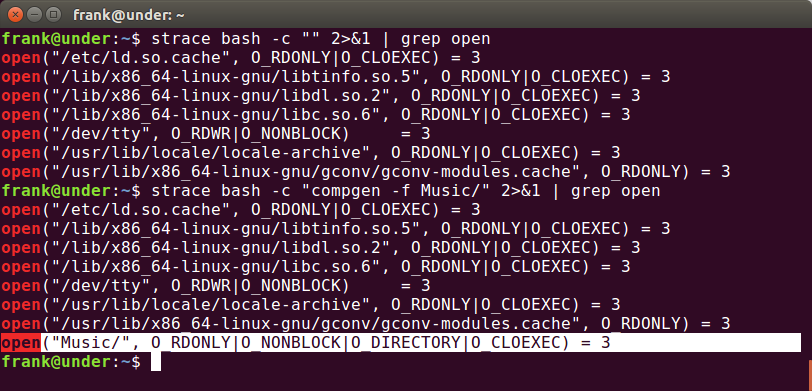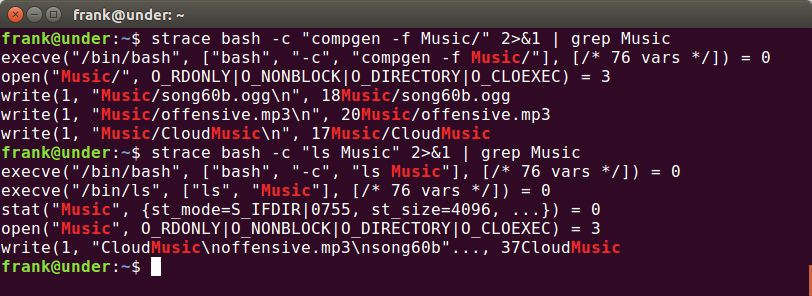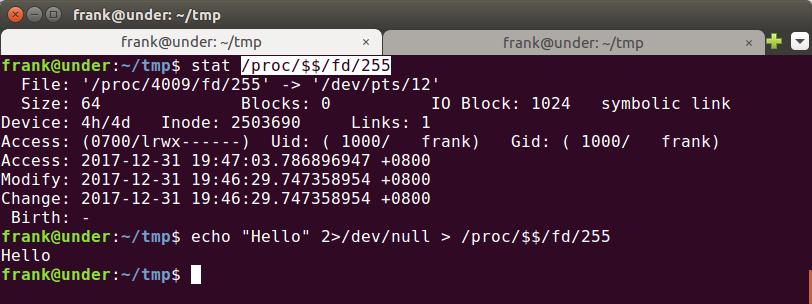ls proc $$ self fd 3 255 引发的一些琐事
我在使用bash的时候通常会利用它的自动补全功能来看看文件夹下的内容(连按两下Tab键),例如:

说明Music文件夹下有这三个文件,我也就不需要提前用ls命令来确定了。
但是最近我在查看当前shell(bash)的文件描述符时时却碰见一个“怪事”,当我用bash的自动补全功能查看时,显示为有0, 1, 2, 255, 3这五个文件:

但是当我用ls命令来显示fd文件夹的时候,却只显示有0, 1, 2, 255这4个文件,3这个文件不存在:

这是为什么呢?
其实原因很简单,自动补全功能是bash内置的一个功能,而ls是系统上的一个程序,以子进程的形式独立于bash运行。所以如果bash这个自动补全功能打开了我们要补全的路径(文件夹也是文件),那么应该会获得文件描述符3,ls也是一样。但是5736这个PID是bash的,所以我们用ls的时候看不到3而用bash的自动补全功能看得到。
为了证实一下这个的想法,上网查了一下相关资料,了解到bash自动补全功能本身就是一个用shell语言写的脚本,其配置在/etc/bash_completion这个文件中,其中常用的内置命令是complete ,用法为complete -F _known_hosts xvncviewer ,即当开头的命令./程序是xvncviewer 的时候,如果用户在参数上连按Tab键就会调用_known_hosts这个shell内置函数 ,例如:
skx@lappy:~$ xvncviewer s[TAB]
savannah.gnu.org ssh.tardis.ed.ac.uk
scratchy steve.org.uk
security.debian.org security-master.debian.org
sun
skx@lappy:~$ xvncviewer sc[TAB]
我们进入/etc/bash_completion文件,查找刚刚使用的ls命令,看看它的自动补全是什么配置的:
complete -F _longopt a2ps awk base64 bash bc bison cat colordiff cp csplit \
cut date df diff dir du enscript env expand fmt fold gperf \
grep grub head indent irb ld ldd less ln ls m4 md5sum mkdir mkfifo mknod \
mv netstat nl nm objcopy objdump od paste pr ptx readelf rm rmdir \
sed seq sha{,1,224,256,384,512}sum shar sort split strip sum tac tail tee \
texindex touch tr uname unexpand uniq units vdir wc who
可以看到,其调用的是_longopt这个内置函数,继续定位:
_longopt()
{
local cur prev words cword split
_init_completion -s || return
case "${prev,,}" in
--help|--usage|--version)
return 0
;;
--*dir*)
_filedir -d
return 0
;;
--*file*|--*path*)
_filedir
return 0
;;
--+([-a-z0-9_]))
local argtype=$( $1 --help 2>&1 | sed -ne \
"s|.*$prev\[\{0,1\}=[<[]\{0,1\}\([-A-Za-z0-9_]\{1,\}\).*|\1|p" )
case ${argtype,,} in
*dir*)
_filedir -d
return 0
;;
#......省略
可以看到_longopt会调用_filedir这个函数:
_filedir()
{
local i IFS=$'\n' xspec
_tilde "$cur" || return 0
local -a toks
local quoted x tmp
_quote_readline_by_ref "$cur" quoted
x=$( compgen -d -- "$quoted" ) &&
while read -r tmp; do
toks+=( "$tmp" )
done <<< "$x"
if [[ "$1" != -d ]]; then
# Munge xspec to contain uppercase version too
# http://thread.gmane.org/gmane.comp.shells.bash.bugs/15294/focus=15306
xspec=${1:+"!*.@($1|${1^^})"}
x=$( compgen -f -X "$xspec" -- $quoted ) &&
while read -r tmp; do
toks+=( "$tmp" )
done <<< "$x"
fi
# If the filter failed to produce anything, try without it if configured to
[[ -n ${COMP_FILEDIR_FALLBACK:-} && \
-n "$1" && "$1" != -d && ${#toks[@]} -lt 1 ]] && \
x=$( compgen -f -- $quoted ) &&
#......省略
可以看到该函数使用了compgen这个内置命令来获取文件夹下的文件名(-f = "filename"),例如:

我们使用strace来追踪这个内置命令的系统调用,特别是返回文件描述符的系统调用open:

通过对比可以看到compgen调用open打开了这个文件夹,而且得到了文件描述符3(前面的open都调用了close删除了它们得到的文件描述符3)。
如果将compgen换成ls :

对比可以看出,compgen只有一个execve ,即compgen是在bash进程中执行的,但ls有两个,第二个说明了它是作为bash的子进程运行的, 证实了我们之前的想法。
如果感兴趣的话可以看看ls的源码,其中使用到了readdir opendir这两个库函数(GNU coreutils-8.29)
综上,我们可以用两个图来总结。
自动补全:
Process: Bash
+-----------------------------+
| |
| 0,1,2,255 0,1,2,3,255|
| Tab->compgen->open |
| |
+-----------------------------+
ls 命令:
Process: Bash
+-----------------------------+
| |
| 0,1,2,255 |
| ls |
| + |
+-----------------------------+
|
|
| Child Process: ls
+------+----------------------+
| |
|0,1,2 0,1,2,3 |
| opendir->open |
+-----------------------------+
另外,如果我们将操作应用于 /proc/self/文件夹也会得到一些有意思的结果:

第一行我们已经讲明白了,但是第二行和第三行怎么解释呢?
在man 5 proc下对这个文件夹的解释是这样的:
/proc/self
This directory refers to the process accessing the /proc
filesystem, and is identical to the /proc directory named by the
process ID of the same process.
也就是说, /proc/self/反应的是当前访问文件的进程的状态数据 ,所以我们用ls /proc/self/fd/实际上是ls /proc/${PID of ls}/fd/ ,而ls会打开这个文件夹(同时获得3这个文件描述符),所以就会看到0,1,2,3这个四个文件了。但如果我们直接ls /proc/self/fd/3 ,这个时候ls的进程还没有获得3这个描述符,就尝试去打开3这个不存在的文件,所以就报错了。在CentOS的文档中提到了这个文件夹的作用:
The /proc/self/ directory is a link to the currently running process. This allows a process to look at itself without having to know its process ID.
另外提一下bash进程中的255文件描述符,这个是bash独有的一个小“trick”,其对应的文件是一个终端设备:

这次碰到的问题抽象点说就是获取信息的手段本身会影响信息,这样的问题在很多地方都有体现,简单的例如用ps aux | wc通过行数来获取进程数,但ps aux本身在运行的时候就会形成一个进程,以后需要注意;)
参考:




 浙公网安备 33010602011771号
浙公网安备 33010602011771号